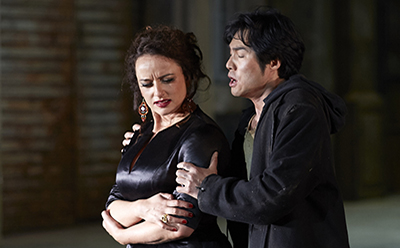 One of the most popular operas in the contemporary operatic repertoire, Georges Bizet’s Carmen offers tantalizing challenges to directors looking for fresh ways to interpret it. Among the more intriguing and successful was a 1943 African-American Broadway version, re-titled Carmen Jones, set in a parachute factory in North Carolina during World War 11, directed by Hazard Short.
One of the most popular operas in the contemporary operatic repertoire, Georges Bizet’s Carmen offers tantalizing challenges to directors looking for fresh ways to interpret it. Among the more intriguing and successful was a 1943 African-American Broadway version, re-titled Carmen Jones, set in a parachute factory in North Carolina during World War 11, directed by Hazard Short.
This new production of Carmen is Opera Australia’s third in as many years, and following his brilliant Tosca last year, John Bell’s interpretation has been much anticipated. Bell has chosen to set his version in Cuba, or as he writes in his program notes, somewhere “resembling today’s Havana”, to allow him to concentrate on the psychology of the Carmen/ Don Jose relationship and to “get away from the traditional setting with its flamenco dancers, gypsies and toreadors”.
Some directors have done this by removing the ensemble scenes altogether, but in this version the opera remains intact, although the synopsis in the printed program confusingly contradicts the director by labelling the four acts as taking place in A square in Seville, Lillas Pastia’s tavern, In the Mountains and Outside the Bullring in Seville.
Michael Scott-Mitchell’s setting with its artfully crumbling Spanish architecture, certainly suggests a plaza, in either Cuba or Seville. However, despite the addition of strings of coloured lights in various scenes; a combi-van which ingeniously converts into a pop-up take-away van for the Lillas Pastia scene; and a truck and some wooden crates for the “mountains/warehouse” scene; the locale determinedly remains the same plaza throughout the opera.
Nor do Teresa Negroponte’s cacophonous party shop costumes provide any sense of period or place, although they do add plenty of unrestrained colour. The final procession before the bullfight, with its piñata horses and garish lycra matador costumes feels more like a carnival than a prelude to a bullfight.
The ensemble work hard at being sultry or cheerful as required, but the staging of the crowd scenes is curiously pedestrian. Kelley Abbey, whose choreography was such a feature of the HOSA version of this opera, does manage to inject some excitement into these scenes with flashy Latin ballroom-dance inspired routines, and some cute rap-dance moves for the children, but as it’s the psychology of the characters in this opera which most interests Bell, this production fires best when the protagonists occupy centre-stage alone.
Making her first appearances with Opera Australia prior to playing this role with New York’s Metropolitan Opera, French mezzo-soprano, Clementine Margaine takes some time to hit her stride. Saddled with seriously dowdy costumes, her seductiveness during the Habanera is very much on the surface, with little back kicks and wrist flicks punctuating her lyrics, as she prowls the stage maneuvering to capture the attention of Don Jose, the only man in the crowd who displays no interest in her at all.
Once the two connect however, the tension between them slowly begins to build, so that by the time she reaches the Card Song in which she is able to reveal the full extent of the warm lustrous tone that extends over the full range of her voice, she is completely immersed in the role.
Korean tenor, Yonghoon Lee is electrifying from the start as Don Jose. Already nominated for a Helpmann Award for his performance in last year’s Turandot, Lee charts a compelling trajectory of a man whose initial indifference eventually turns into a fatal attraction and then uncontrollable obsession.
His singing is as thrilling as his acting, especially during the lovely Flower Song, so that by the time the final scene is reached, his descent from fresh faced youth to wild-eyed psychopath has been so convincingly charted that its inevitability is absolutely shattering.
Natalie Aroyan’s interpretation of Don Jose’s abandoned fiancé is delightfully convincing and beautifully sung, but Michael Honeyman’s Escamillo, costumed oddly in a red satin suit, was curiously avuncular and under-powered.
Among the smaller roles, Jane Ede and Margaret Trubiano, as Carmen’s friends Frasquita and Mercedes, and Luke Gabbedy and Kanen Breen as the smugglers Dancairo and Remendado each lit up the stage on every appearance, as did Adrian Tamburini as the swarthy soldier, Zuniga.
Bizet’s remarkable score was superbly interpreted by the Australian Opera and Ballet Orchestra under the baton of Andrea Molino, with their playing of intermezzos between acts being especially satisfying. But the score conjures up visions of all things Spanish so cogently that despite the excellent singing and dramatic clarity of this production the music seemed distractingly at odds with the garish Cuban-inspired visuals of this production.
Conductor: Andrea Molino Director: John Bell Set Design: Michael Scott-Mitchell Lighting Designer: Trent Suidgeest Costume Design: Teresa Negroponte Choreography: Kelley Abbey Presented by: Opera Australia
Carmen
Joan Sutherland Theatre – Sydney Opera House, Bennelong Point
Performance: Tuesday 21 June 2016
Season continues to 12 August 2016
Information and Bookings: www.opera.org.au
Image: Clémentine Margaine (Carmen) and Yonghoon Lee (Don José) in Opera Australia’s production of Carmen – photo by Keith Saunders
Review: Bill Stephens
